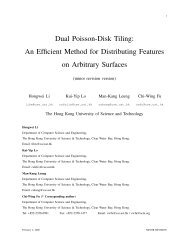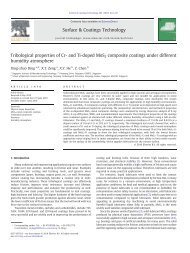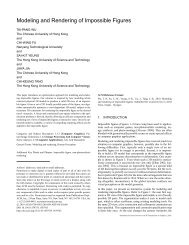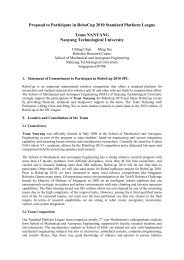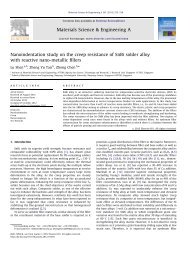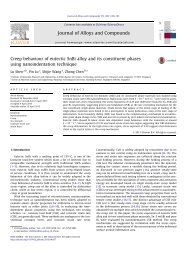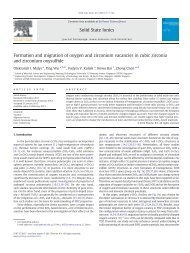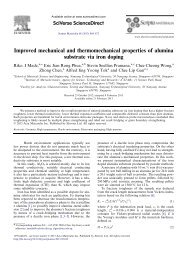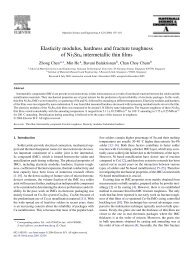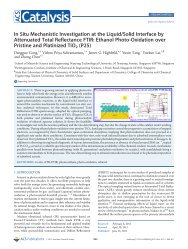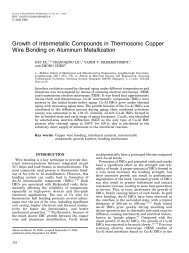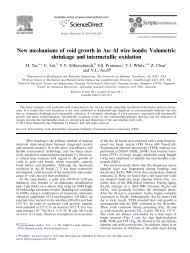Decoding Collided Acknowledgement Transmission in IEEE 802.11 ...
Decoding Collided Acknowledgement Transmission in IEEE 802.11 ...
Decoding Collided Acknowledgement Transmission in IEEE 802.11 ...
Create successful ePaper yourself
Turn your PDF publications into a flip-book with our unique Google optimized e-Paper software.
which shows that c is a column of MN. S<strong>in</strong>ce Ω+(G1, c) =<br />
Ω−(G1, c), by (3) we thus have F (G1, c) = 0.<br />
Proposition 1: Consider a certa<strong>in</strong> system with N stations<br />
where N ≥ 1. For any G1, G2 ⊂ G and G1, G2 = ∅, −→ G1 = −→ G2<br />
iif G1 = G2.<br />
Proof: By def<strong>in</strong>ition given <strong>in</strong> (4), we can easily see that<br />
if G1 = G2, then −→ G1 = −→ G2. In the follow<strong>in</strong>g, we shall prove<br />
that if G1 = G2, then −→ G1 = −→ G2.<br />
We will exam<strong>in</strong>e two cases: (i) |G1| is an odd <strong>in</strong>teger; (ii)<br />
|G1| is an even <strong>in</strong>teger. Without loss of generality, we assume<br />
that |G1| ≥ |G2|.<br />
Case (i): |G1| is an odd <strong>in</strong>teger. Let g = |G1|. Based on<br />
lemma 1, there exists a column c <strong>in</strong> MN such that<br />
and hence accord<strong>in</strong>g to (4), we also have<br />
−→<br />
G1(c) = 1.<br />
F (G1, c) = 1, (6)<br />
This column will have the follow<strong>in</strong>g property<br />
Ω+(G1, c) = g+1<br />
2<br />
Ω−(G1, c) = Ω+(G1, c) − 1 = g−1<br />
2<br />
Ω+(G ′ 1, c) = Ω−(G ′ 1, c) = N−g<br />
2<br />
with any permutation.<br />
If G1 = G2, there exists K1 = G1 \ G2 = ∅ and K2 =<br />
G2 \ G1 where |K1| = k1 ≥ 1 and |K2| = k2 ≥ 0. It is clear<br />
that K1 ⊆ G1, K2 ⊆ G ′ 1 imply<br />
1 ≤ k1 ≤ g, k2 ≤ N − g.<br />
where g is an odd <strong>in</strong>teger and N − g is an even <strong>in</strong>teger.<br />
With the above condition, there exists a permutation with<strong>in</strong><br />
c such that<br />
Ω+(K1, c) = ⌊ k1<br />
g+1<br />
2 ⌋ + 1 ≤ 2<br />
Ω−(K1, c) = ⌊ k1−1 g−1<br />
2 ⌋ ≤ 2<br />
Ω+(K2, c) = ⌊ k2 N−g<br />
2 ⌋ ≤ 2<br />
Ω−(K2, c) = ⌊ k2+1 N−g<br />
2 ⌋ ≤ 2<br />
that confirms K1 ⊆ G1, K2 ⊆ G ′ 1 given (7). The immediate<br />
result gives<br />
and<br />
which yield<br />
F (K1, c) =<br />
F (K2, c) =<br />
1, k1 = 1, 3, ...<br />
2, k1 = 2, 4, ...<br />
−1, k2 = 1, 3, ...<br />
0, k2 = 0, 2, 4, ...<br />
(7)<br />
(8)<br />
(9)<br />
F (K1, c) − F (K2, c) ≥ 1. (10)<br />
S<strong>in</strong>ce G2 = (G1 \ K1) ∪ K2, with (6) and (10), we obta<strong>in</strong><br />
F (G2, c) = F (G1, c) − F (K1, c) + F (K2, c) ≤ 0<br />
and hence −→ G2(c) = 0. S<strong>in</strong>ce −→ G1(c) = 1, there exists a column<br />
<strong>in</strong> MN such that −→ G2(c) = −→ G2(c), which is sufficient to show<br />
that −→ G1 = −→ G2.<br />
Case (ii): |G1| is an even <strong>in</strong>teger. Let g = |G1|. Based on<br />
lemma 2, there exists a column c <strong>in</strong> MN such that<br />
and hence accord<strong>in</strong>g to (4), we also have<br />
−→<br />
G1(c) = 0.<br />
F (G1, c) = 0 (11)<br />
This column will have the follow<strong>in</strong>g property<br />
Ω+(G1, c) = Ω−(G1, c) = g<br />
2<br />
Ω+(G ′ 1, c) = N−g+1<br />
2<br />
Ω−(G ′ 1, c) = N−g−1<br />
2<br />
(12)<br />
with any permutation.<br />
If G1 = G2, there exist K1 = G1 \ G2 = ∅ and K2 =<br />
G2 \ G1 where |K1| = k1 ≥ 1 and |K2| = k2 ≥ 0. It is clear<br />
that K1 ⊆ G1, K2 ⊆ G ′ 1 imply<br />
1 ≤ k1 ≤ g, k2 ≤ N − g.<br />
where g is an nonzero even <strong>in</strong>teger and N −g is an odd <strong>in</strong>teger.<br />
We first exclude the condition where k2 = 0. With the above<br />
condition, there exists a permutation with<strong>in</strong> c such that<br />
Ω+(K1, c) = ⌊ k1 g<br />
2 ⌋ ≤ 2<br />
Ω−(K1, c) = ⌊ k1+1 g<br />
2 ⌋ ≤ 2<br />
Ω+(K2, c) = ⌊ k2<br />
N−g+1<br />
2 ⌋ + 1 ≤ 2<br />
Ω−(K2, c) = ⌊ k2−1 N−g−1<br />
2 ⌋ ≤ 2<br />
that confirms K1 ⊆ G1, K2 ⊆ G ′ 1 given (12). The immediate<br />
result gives<br />
and<br />
which yield<br />
F (K1, c) =<br />
F (K2, c) =<br />
−1, k1 = 1, 3, ...<br />
0, k1 = 2, 4, ...<br />
1, k2 = 1, 3, ...<br />
2, k2 = 2, 4, ...<br />
(13)<br />
(14)<br />
F (K2, c) − F (K1, c) ≥ 1. (15)<br />
For k2 = 0 which implies G2 ⊂ G1, s<strong>in</strong>ce G2 cannot be<br />
empty, k1 = g − |G2| must be ≤ g, there exists another permutation<br />
<strong>in</strong> c such that Ω+(K1, c) < Ω−(K1, c) ≤ Ω−(G1, c)<br />
giv<strong>in</strong>g<br />
F (K1, c) =<br />
−1, k1 = 1, 3, ...<br />
−2, k1 = 2, 4, ...<br />
(16)<br />
and F (K2, c) − F (K1, c) ≥ 1 as <strong>in</strong> (15) s<strong>in</strong>ce F (K2, c) = 0.<br />
Given that G2 = (G1 \ K1) ∪ K2, with (11) and (15), we<br />
obta<strong>in</strong><br />
F (G2, c) = F (G1, c) − F (K1, c) + F (K2, c) ≥ 1<br />
and hence −→ G2(c) = 1. S<strong>in</strong>ce −→ G1(c) = 0, there exists a column<br />
<strong>in</strong> MN such that −→ G2(c) = −→ G2(c) which is sufficient to show<br />
that −→ G1 = −→ G2.<br />
With the above two cases, we have proven that if G1 = G2,<br />
then −→ G1 = −→ G2. Together with the earlier establishment that if<br />
G1 = G2, then −→ G1 = −→ G2, we conclude that for any G1, G2 ⊂<br />
G and G1, G2 = ∅, −→ G1 = −→ G2 iif G1 = G2.



